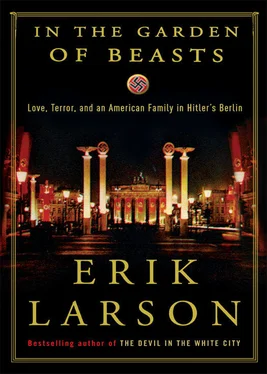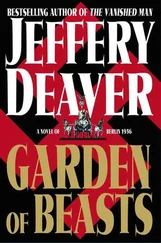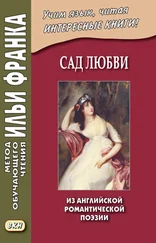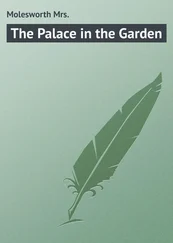Dodd wrote: “These instances and others of lesser importance reveal a different method in the treatment of the Jews—a method perhaps less calculated to bring repercussions from abroad, but reflecting nonetheless the Nazis’ determination to force the Jews out of the country.”
Germany’s Aryan population also experienced a new tightening of control. In another dispatch written the same day, Dodd described how the Ministry of Education had announced that the school week would be divided in such a way that Saturdays and Wednesday evenings would be devoted to the demands of the Hitler Youth.
Henceforth Saturday was to be called the Staatsjugendtag, the State’s Day for Youth.
THE WEATHER REMAINED WARM, with scant rain. On Saturday, June 2, 1934, with temperatures in the eighties, Ambassador Dodd wrote in his diary: “Germany looks dry for the first time; trees and fields are yellow. The papers are full of accounts of the drought in Bavaria and in the United States as well.”
In Washington, Moffat also took note of the weather. In his diary he called it “the great heat” and cited Sunday, May 20, as the day it had begun, with a high of ninety-three degrees. In his office.
No one knew it yet, of course, but America had entered the second of a series of cataclysmic droughts that soon would transform the Great Plains into the Dust Bowl.
CHAPTER 41
Trouble at the Neighbor’s
As summer neared, the sense of unease in Berlin became acute. The mood was “tense and electric,” Martha wrote. “Everyone felt there was something in the air but did not know what it was.”
The strange atmosphere and the fragile condition of Germany were topics of conversation at a late-afternoon Tee-Empfang —a tea party—hosted by Putzi Hanfstaengl on Friday, June 8, 1934, which the Dodd family attended.
On their way home from the tea, the Dodds could not help but notice that something unusual was happening in Bendlerstrasse, the last side street they passed before reaching their house. There, in easy view, stood the buildings of the Bendler Block, army headquarters. Indeed, the Dodds and the army were almost back-fence neighbors—a man with a strong arm could throw a stone from the family’s yard and expect to break one of the army’s windows.
The change was obvious. Soldiers stood on the roofs of headquarters buildings. Heavily armed patrols moved along the sidewalks. Army trucks and Gestapo cars clogged the street.
These forces remained throughout Friday night and Saturday. Then, Sunday morning, June 10, the troops and trucks were gone.
At the Dodds’ house a coolness spread outward from the forested ground of the Tiergarten. There were riders in the park, as always, and the thud of hooves was audible in the Sunday-morning quiet.
CHAPTER 42
Hermann’s Toys
Amid the many rumors of coming upheaval, it remained difficult for Dodd and his peers in the diplomatic corps to imagine that Hitler, Göring, and Goebbels could endure much longer. Dodd still saw them as inept and dangerous adolescents—“16 year olds,” as he now put it—who found themselves confronting an accumulation of daunting troubles. The drought grew steadily more severe. The economy showed little sign of improvement, other than the illusory decline in unemployment. The rift between Röhm and Hitler seemed to have deepened. And there continued to be moments—strange, ludicrous moments—that suggested that Germany was merely the stage set for some grotesque comedy, not a serious country in a serious time.
Sunday, June 10, 1934, provided one such episode, when Dodd, French ambassador François-Poncet, and Britain’s Sir Eric Phipps, along with three dozen other guests, attended a kind of open house at Göring’s vast estate an hour’s drive north of Berlin. He had named it Carinhall for his dead Swedish wife, Carin, whom he revered; later in the month he planned to exhume her body from its resting place in Sweden, transport it to Germany, and entomb it in a mausoleum on the estate grounds. Today, however, Göring wanted merely to show off his forests and his new bison enclosure, where he hoped to breed the creatures and then turn them loose on his grounds.
The Dodds arrived late in their new Buick, which had betrayed them along the way with a minor mechanical failure, but they still managed to arrive before Göring himself. Their instructions called for them to drive to a particular point on the estate. To keep guests from getting lost, Göring had stationed men at each crossroads to provide directions. Dodd and his wife found the other guests gathered around a speaker who held forth on some aspect of the grounds. The Dodds learned they were at the edge of the bison enclosure.
At last Göring arrived, driving fast, alone, in what Phipps described as a racing car. He climbed out wearing a uniform that was partly the costume of an aviator, partly that of a medieval hunter. He wore boots of India rubber and in his belt had tucked a very large hunting knife.
Göring took the place of the first speaker. He used a microphone but spoke loudly into it, producing a jarring effect in the otherwise sylvan locale. He described his plan to create a forest preserve that would reproduce the conditions of primeval Germany, complete with primeval animals like the bison that now stood indolently in the near distance. Three photographers and a “cinematograph” operator captured the affair on film.
Elisabetta Cerruti, the beautiful Hungarian and Jewish wife of the Italian ambassador, recalled what happened next.
“Ladies and gentlemen,” Göring said, “in a few minutes you will witness a unique display of nature at work.” He gestured toward an iron cage. “In this cage is a powerful male bison, an animal almost unheard of on the Continent…. He will meet here, before your very eyes, the female of his species. Please be quiet and don’t be afraid.”
Göring’s keepers opened the cage.
“Ivan the Terrible,” Göring commanded, “I order you to leave the cage.”
The bull did not move.
Göring repeated his command. Once again the bull ignored him.
The keepers now attempted to prod Ivan into action. The photographers readied themselves for the lustful charge certain to ensue.
Britain’s Ambassador Phipps wrote in his diary that the bull emerged from the cage “with the utmost reluctance, and, after eyeing the cows somewhat sadly, tried to return to it.” Phipps also described the affair in a later memorandum to London that became famous within the British foreign office as “the bison dispatch.”
Next, Dodd and Mattie and the other guests climbed aboard thirty small, two-passenger carriages driven by peasants and set off on a long, meandering ride through forests and across meadows. Göring was in the lead in a carriage pulled by two great horses, with Mrs. Cerruti seated to his right. An hour later, the procession halted near a swamp. Göring climbed from his carriage and gave another speech, this on the glories of birds.
Once again the guests climbed into their carriages and, after another lengthy ride, came to a glade where their cars stood waiting. Göring levered his massive self into his car and raced off at high speed. The other guests followed at a slower pace and after twenty minutes came to a lake beside which stood an immense, newly constructed lodge that seemed meant to evoke the home of a medieval lord. Göring was waiting for them, dressed in a wholly new outfit, “a wonderful new white summer garb,” Dodd wrote—white tennis shoes, white duck trousers, white shirt, and a hunting jacket of green leather, in whose belt the same hunting knife appeared. In one hand he held a long implement that seemed a cross between a shepherd’s staff and a harpoon.
Читать дальше












